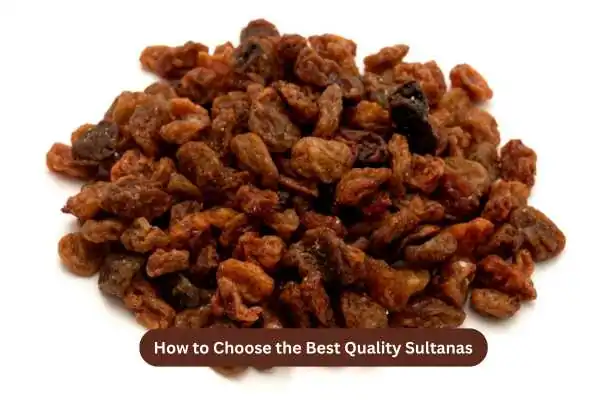Sultanas are a staple in many UK households, loved for their natural sweetness and versatility in both sweet and savoury dishes. Whether you’re adding them to your morning porridge, baking traditional fruit cakes, or using them in Middle Eastern recipes, the quality of sultanas you choose can significantly impact flavour, texture, and nutritional value.

In this guide, we’ll explore exactly how to choose the best quality sultanas available on the market. From understanding where they come from to checking key indicators of freshness, you’ll be well equipped to pick the best product for your kitchen.
What Are Sultanas?
Sultanas are dried grapes, typically made from Thompson Seedless or similar white grape varieties. Unlike raisins or currants, sultanas are known for their light golden colour, soft texture, and naturally sweet taste. They are often treated with a drying solution (such as potassium carbonate and vegetable oil) to speed up the drying process and preserve colour.
In the UK, sultanas are commonly used in traditional baking, such as fruit loaves, mince pies, and hot cross buns, as well as in savoury dishes like Moroccan tagines.
1. Check the Appearance
Visual inspection is one of the easiest ways to assess sultana quality. High-quality sultanas should have:
-
Even colour: Look for a uniform golden-brown shade. Extremely dark or uneven colouring can indicate age or improper drying.
-
Plumpness: Good sultanas should look plump and slightly glossy, not shrivelled or dry.
-
Minimal crystallisation: If you notice a white, dusty coating, it could be sugar crystallisation—an indication the fruit is old or poorly stored.
Avoid sultanas that look excessively hard, dry, or have visible signs of mould or sugar bloom.
2. Feel the Texture
When handling sultanas, they should feel soft and slightly sticky, not brittle. A quick squeeze should confirm their moisture level. Overly dry or hard sultanas may be past their prime or improperly stored.
If you’re buying pre-packaged sultanas, gently press the packet. It should feel flexible and not overly clumped or stiff. Clumping can indicate exposure to humidity or temperature changes.
3. Smell the Aroma
Fresh sultanas have a mildly sweet, fruity scent. If they smell sour, musty, or fermented, they may be expired or stored incorrectly. Always trust your nose when it comes to dried fruits—a bad smell is a clear red flag.
4. Consider the Source
The country of origin can impact the taste and quality of sultanas. Some of the best quality sultanas come from:
-
Turkey – Known for large, sweet sultanas with soft texture.
-
Australia – Produces premium golden sultanas with fewer additives.
-
Iran and Greece – Offer rich-flavoured, sun-dried varieties.
Opt for suppliers who clearly label the source and offer information about how the fruit is processed. Organic and sulphur-free options are also available for those looking for more natural choices.
5. Read the Ingredients
While sultanas should ideally contain just one ingredient—sultanas—many commercial brands include preservatives (such as sulphur dioxide) or coating agents (like vegetable oil) to maintain softness and prevent sticking.
For the most natural flavour and nutritional benefit, look for:
-
Organic sultanas
-
Sulphite-free
-
No added sugars or oils
Always check the label if you have dietary restrictions or prefer clean eating.
6. Look at the Packaging
Packaging plays a crucial role in maintaining freshness. When selecting sultanas:
-
Choose airtight, resealable packs to retain moisture.
-
Avoid packaging with any tears, holes, or signs of condensation inside.
-
Opt for opaque packaging or store-brand pouches that block out light, which can degrade quality over time.
Bulk sultanas from refill stations can be a great eco-friendly option—just ensure the store maintains good hygiene and turnover.
7. Check the Expiry Date
Always check the “best before” date on the packaging. While dried fruits have a long shelf life, older stock may lose flavour and become tough over time.
In shops with high turnover, like health food stores or larger supermarkets, you’re more likely to find fresher sultanas with better moisture content and taste.
8. Consider Organic and Fair Trade Options
If quality, sustainability, and ethical sourcing matter to you, consider choosing:
-
Organic sultanas – Free from synthetic pesticides and additives.
-
Fair Trade certified products – Support better labour practices and community welfare in producing countries.
While these may come at a slightly higher price, the quality and peace of mind they offer often make them worthwhile.
9. Taste Before Buying (When Possible)
In farmer’s markets or local health food shops, you might be allowed to sample the product before buying. High-quality sultanas should taste:
-
Naturally sweet without being sugary
-
Rich and fruity, with no sour or fermented aftertaste
-
Soft and chewy, not tough or rubbery
When tasting isn’t possible, buying from a trusted brand or supplier with good reviews is your next best option.
10. Proper Storage Matters
Once you’ve chosen your sultanas, store them correctly to maintain their quality:
-
Keep them in an airtight container in a cool, dry place.
-
For long-term storage, refrigeration can extend shelf life without hardening.
-
Avoid exposing them to moisture or direct sunlight.
Proper storage ensures that your high-quality sultanas stay fresh and flavourful for weeks or even months.
Final Thoughts
Choosing the best quality sultanas doesn’t have to be complicated. By paying attention to visual cues, texture, aroma, and origin, you can ensure you’re getting a product that enhances your cooking and supports your health. Whether you’re baking traditional British recipes or adding natural sweetness to your everyday meals, starting with the right sultanas makes all the difference.
Armed with these tips, you’ll be ready to confidently select the freshest, most flavourful sultanas available across UK stores or online. Happy shopping—and happy snacking!

